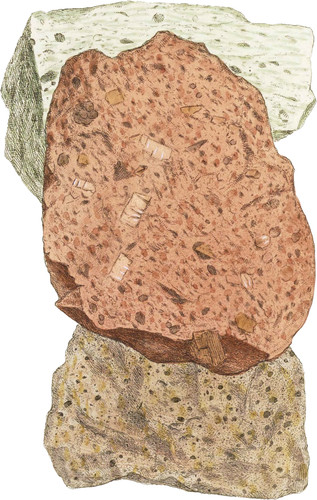 Enlarge
Enlarge
British Mineralogy
Porphyry. Feldspar Porphyry
It is comfortable to Moses that the Earth was without form and void, and that the Earth was covered with water, which was to be gathered together in one place, and let the dry land appear: when this took place, it won hi happen in the separation of the Earth from the waters, that it would naturally he more or less crystallized, which agrees with what we see: the most perfect, or those that have been least disturbed in largest crystals, and the rest becoming more and more mingled, especially if agitated, as appears to have been the case; this happens in most solutions, even in artificial ones.
Rocks composed of a basis, through which are dispersed crystals, are called Porphyries; such as are said to belong to what is considered the oldest rock, are a sort of muddy or amorphous remains of some of the component parts of that rock, viz. Quartz, Feldspar and Mica, with either one or more in the form of crystals: those belonging to later formations partake of the nature of the respective rocks, such as Pitchstone Porphyry, Claystone Porphyry, &c. The present specimens are from the older rocks of the Grampians, in Scotland, and are thus related to them. The upper one has a siliceous base approaching to an Hornstone with crystallized remains of Quartz, Feldspar, and Mica, scattered in it. The middle specimen is chiefly reddish Feldspar, in which some is imbedded in crystals, &e. with Quartz and spots of Feldspar, containing Clay, Chlorite, &c.*
Feldspar when in a state of incipient decay is apt to have the odour of a clayey stone as this has. The lowest specimen is commonly called a Claystone Porphyry, and is also scented; this seems to contain many ingredients, it has at least the addition of an ochraceous oxyde of Iron, and if I may judge from the pinky hue of the basis, it is tinted with Manganese, The Feldspar is not so prominent as the Mica, which gives the dark spotted appearance: the Quartz is inconspicuous.
Porphyry was much used by the Egyptians, Romans, &c. and after choosing admirable specimens, mostly with a hard red jasperine ground, with that intelligent preference that proved their judgment, as, is shown by the excellent works for which it is used in architecture or statuary, still preserved to confute those who might have doubted their attainments; they probably worked it with well hardened tools, with much patience, and ground it to their purpose with emery or other hard materials, and polished it as we do Carnelians, Agate, &c. with Rotten-stone or something to answer a similar purpose. These red Porphyrys were probably found in Egypt imbedded in their Sienitio Rocks, which they used in their greater works, the well-known Cleopatra’s needle and Pompey’s pillar being made of it with immense labour. We are now advanced in the use and art of cutting Granite for buildings, which is, perhaps, a promise of attaining at some future period their perfection, though they will still have the merit of originality.
- * This variety, by the accurate attention of Colonel Imrie, is shown to constitute vertical Dykes, stretching nearly from N. to S. whose course cuts the line of the Grampian bills nearly at right angles. The specimens figured in thsi plate are in the Cabinet of the Geological Society.

